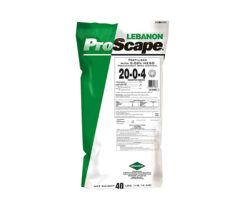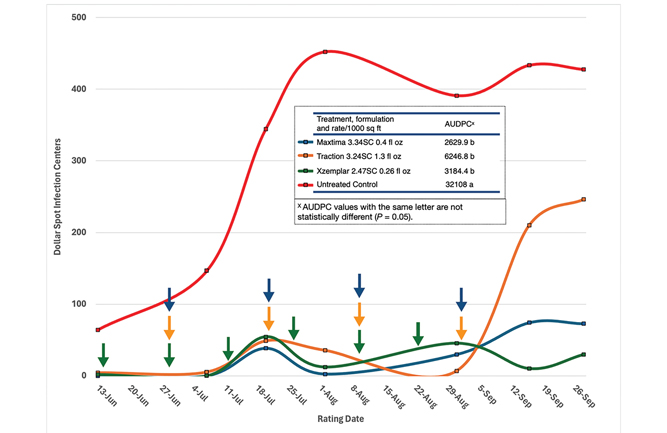Heed the overseed

Overseeding can help golf course superintendents achieve vibrant green turfgrass, especially in the South during winter. (Photo: Brian Whitlark, USGA)
Typically performed in October, overseeding is the planting of seed directly into existing turf. It serves as a way to help keep grass looking healthy.
“Overseeding is driven by golfer preference. Golfers in many markets want to play on vibrant, green turf during the winter months, and they’ll pay a premium for that,” says Clark Throssell, Ph.D., research editor for Golfdom. “It’s all about snowbird people getting away from winter up north, and they want to play on a green golf course during the winter months.”
Planning for overseeding usually occurs months in advance, and a one- to two-week window is chosen, based on agronomic factors and when there may be a lull in play.
It’s important to have materials on hand and ready to go once that overseeding window approaches.
In some cases, superintendents can apply chemical treatments to help slow the growth of bermudagrass prior to overseeding; in other cases, superintendents may scalp the bermudagrass to some degree to help the seed filter down to the soil surface.
Whatever the case, Throssell says when it comes time to overseed, it’s important to ensure that the seed is distributed uniformly.
“Superintendents have gotten really good at making sure they have precise, sharp lines where there is a good stand of seed and not a straggler or stray seed here or there,” Throssell says. “That’s just practice and paying attention to detail.”

Bob Hartman (Photo: Knox Fertilizer Co.)
Knox Fertilizer Co.
Bob Hartman
Director of sales and marketing
Overseeding of turf consisting of cool-season grasses is best done in late summer or early fall. In the fall, the germination — the new grass — will have several months to become established before air temperatures decline and the growth slows and ultimately stops. It’s also best to kill summer weeds prior to seeding so new turf is not competing with summer weedy grasses. Always follow the label of the herbicide to allow for the proper time window from application to seeding. It’s extremely important that the grass seeds stay moist throughout the germination process. It’s a balance between under- and overwatering. Too much water can produce root rot, and too little water can dry out the young plants. Fertilizing during the overseeding process also can lead to higher germination rates and thicker established grass. Fertilizers that are high in phosphorus are ideal when overseeding or planting new grass.

Tony Goldsby (Photo: The Andersons)
The Andersons
Tony Goldsby, Ph.D.
Research agronomist
Overseeding with a cool-season turfgrass like perennial ryegrass is common in the southern U.S. during bermudagrass dormancy. This process will result in green turfgrass on the golf course throughout the winter months. One of the keys to success with a good transition is to completely stop fertilizing the bermudagrass four to six weeks prior to overseeding with perennial ryegrass. This will allow bermudagrass growth to slow prior to reducing the mowing height in preparation for seeding. Once the ryegrass has germinated and you have resumed mowing, it’s time to make your first nitrogen fertilizer application. Ideally, using a quick-release source of nitrogen will help ensure your perennial ryegrass gets a good boost in top growth.

Christopher Gray Sr. (Photo: LebanonTurf)
LebanonTurf
Christopher Gray Sr.
Golf channel manager
One of the most common causes of failure with overseeding is fertilizer burn, which you can avoid by following a few simple practices. You’ll want to apply a granular fertilizer application such as 16-4-8 with quick-release nitrogen such as ammonium sulfate, at 1 pound of nitrogen per 1,000 square feet immediately after seeding so you eliminate any chance of burning young seedlings. After the seed pops, light applications of nitrogen will help produce a healthy and dense stand of overseeded turf. You can accomplish this with either additional granular products with soluble nitrogen — like urea or ammonium sulfate — or with foliar-applied liquid products. With either option, I would only recommend applying no more than a 0.5 pound of nitrogen per 1,000 square feet every seven to 14 days. If you do choose to spray a liquid product, you also can include a fungicide in the spray tank to help protect the young seedlings.

Bret Corbett (Photo: Prime Source)
Prime Source
Bret Corbett
Director of technical services
Overseeding is a common practice in areas where the warm-season turf goes dormant in the winter months. For superintendents, it’s important to overseed to retain a green turf sward for aesthetics and playability. Preparation is a key to ensure seed germination. Healthy plants start in the soil. Soil testing eliminates the guesswork when applying nutrients. In early fall, I typically recommend a starter fertilizer to help promote healthy roots. Next, select the best seeds. Superintendents need to stay up to date with the National Turfgrass Evaluation Program to find the best new varieties and cultivars. It’s always good to check the quality of the seed in each bag, including the germination rate as well as weed/seed percentage. Last, calibrate the spreader each year. This can ensure superintendents are applying the proper fertilizer and seed rate.












